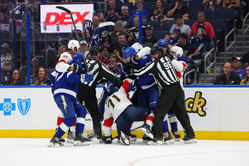
The Stanley Cup playoffs are the annual tournament that decides the NHL champion and winner of the Stanley Cup. The trophy began in 1892 as the Dominion Hockey Challenge Cup, named by Lord Stanley of Preston. It was first awarded through challenge games between league champions and opened to professional teams in 1906.
In 1914, the NHA and PCHA agreed to contest the Cup annually, ending challenge matches. After the NHL formed in 1917, the Cup was shared with the PCHA and WCHL until 1926. From that point, the NHL took full control. The playoffs became part of league operations, adjusting with each expansion and format change through the modern era.
How many NHL teams make the playoffs?
A total of 16 NHL teams make the playoffs, as per the official website of the NHL. The top three teams from each of the four divisions qualify, making 12 teams. The remaining four spots go to the two highest-ranked teams in each conference that didn’t finish in the top three of their division—these are the wild card teams.
The playoffs are divided into four rounds: the first round, the conference semifinals, the conference finals, and the Stanley Cup Final. Each round is a best-of-seven series, with the higher-seeded team having home-ice advantage in games 1, 2, 5, and 7, while the lower-seeded team has home-ice advantage in games 3, 4, and 6 if necessary.
Read More: NHL Playoff Bracket
NHL playoff format
The NHL playoff format has four rounds, each a best-of-seven series. The team with home-ice advantage hosts Games 1, 2, 5, and 7; the opponent hosts Games 3, 4, and 6. The last three games are only played if needed.
Eight teams from each conference qualify: the top three from each division, plus two wild cards based on point totals. In the first round, each conference has two brackets. Division winners face wild-card teams, while second- and third-place teams from each division play each other.
Winners move to the second round, then to the conference finals, and finally to the Stanley Cup Final. There is no reseeding. Home-ice advantage goes to the higher seed in the first two rounds and to the team with the better regular-season record in the last two rounds.
NHL playoff rules
The NHL playoffs involve 16 teams: the top three from each division plus two wild-card teams per conference, based on regular-season points. Seeding uses tiebreakers like regulation wins (RW), regulation and overtime wins (ROW), total wins, head-to-head points, goal differential, and goals for (GF). If all tiebreakers fail, a one-game playoff is used.
Each playoff round is a best-of-seven series. Games tied after regulation go to a full 20-minute, 5-on-5 sudden-death overtime. If still tied, more 20-minute overtimes are played until one team scores. Unlike the playoffs, regular-season overtimes are 5-minute 3-on-3. If still tied, games go to a shootout to determine the winner. Playoff games do not use shootouts.
Read More: NHL Playoff Tickets
FAQ's On NHL Playoffs
A. In the NHL, 16 out of the total 32 teams qualify for the playoffs, with eight teams from each conference (Eastern and Western) competing in a seeded bracket format.
A. The Florida Panthers won their first Stanley Cup in the 2023–24 season.
A. The NHL playoffs will start on 19th April and last till mid-June.
A. The Montreal Canadiens hold the record with 25 championships.
A. Sixteen teams qualify for the NHL Playoffs.









